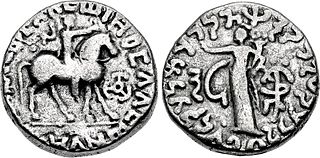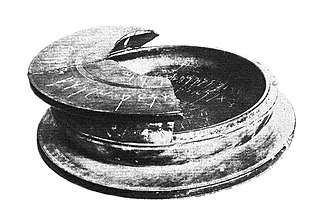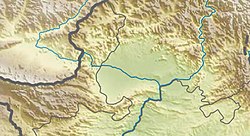
The Indo-Greek Kingdom, also known as the Yavana Kingdom, was a Hellenistic-era Greek kingdom covering various parts of modern-day Afghanistan, Pakistan and northwestern India. It existed from c. 200 BC to c. 10 AD.

The Indo-Scythians were a group of nomadic people of Iranic Scythian origin who migrated from Central Asia southward into the northwestern Indian subcontinent: the present-day South Asian regions of Afghanistan, Pakistan, Eastern Iran and northern India. The migrations persisted from the middle of the second century BCE to the fourth century CE.

The Kanishka casket or Kanishka reliquary, is a Buddhist reliquary made in gilded copper, and dated to the first year of the reign of the Kushan emperor Kanishka, in 127 CE. It is now in the Peshawar Museum in the historic city of Peshawar, Pakistan.
Theodorus was a "meridarch" in the Swat province of the Indo-Greek kingdom in the northern Indian subcontinent, probably sometime between 100 BCE and the end of Greek rule in Gandhara in 55 BCE.

The Bimaran casket or Bimaran reliquary is a small gold reliquary for Buddhist relics that was removed from inside the stupa no.2 at Bimaran, near Jalalabad in eastern Afghanistan.

The Mathura lion capital is an Indo-Scythian sandstone capital from Mathura in Northern India, dated to the first decade of the 1st century CE. It was consecrated under the rule of Rajuvula, one of the Northern Satraps of the region of Mathura.

Kharahostes or Kharaosta was an Indo-Scythian ruler in the northern Indian subcontinent around 10 BCE – 10 CE. He is known from his coins, often in the name of Azes II, and possibly from an inscription on the Mathura lion capital, although another satrap Kharaostes has been discovered in Mathura.
The Taxila copper-plate, also called the Moga inscription or the Patika copper-plate is a notable archaeological artifact found in the area of Taxila, Gandhara, in modern Pakistan. It is now in the collection of the British Museum.

The Apracharajas, also known as Avacarajas, were a local ruling dynasty of Gandhara. The Apracharaja capital, known as Apracapura, was located in Bajaur, though from numismatic evidence and reliquary inscriptions, it is asserted that their territory encompassed the wider region of Gandhara, including the cities of Taxila and Pushkalavati. Under the administration of Sases, their domain expanded to incorporate the former territory of the kingdom of Porus, which extended as far as the river Ravi in the Punjab.

Vijayamitra was an Apracharaja who ruled in Gandhara, with his capital in Bajaur. He succeeded the previous Apracharaja, Visnuvarma, in 3 BCE with a reign lasting til 32 CE.

The Indo-Greeks practiced numerous religions during the time they ruled in the northwestern Indian subcontinent from the 2nd century BCE to the beginning of the 1st century CE. In addition to the worship of the Classical pantheon of the Greek deities found on their coins, the Indo-Greeks were involved with local faiths, particularly with Buddhism, but also with Hinduism and Zoroastrianism.

Indo-Greek art is the art of the Indo-Greeks, who reigned from circa 200 BC in areas of Bactria and the Indian subcontinent. Initially, between 200 and 145 BC, they remained in control of Bactria while occupying areas of Indian subcontinent, until Bactria was lost to invading nomads. After 145 BC, Indo-Greek kings ruled exclusively in parts of ancient India, especially in Gandhara, in what is now present-day the northwestern Pakistan. The Indo-Greeks had a rich Hellenistic heritage and artistic proficiency as seen with the remains of the city of Ai-Khanoum, which was founded as a Greco-Bactrian city. In modern-day Pakistan, several Indo-Greeks cities are known such as Sirkap near Taxila, Barikot, and Sagala where some Indo-Greek artistic remains have been found, such as stone palettes.

The Bajaur casket, also called the Indravarma reliquary, year 63, or sometimes referred to as the Avaca inscription, is an ancient reliquary from the area of Bajaur in ancient Gandhara, in the present-day Khyber Pakhtunkhwa, Pakistan. It is dated to around 5–6 CE. It proves the involvement of the Scythian kings of the Apraca, in particular King Indravarman, in Buddhism. The casket is made of schist.

The Silver Reliquary of Indravarman is an inscribed silver Buddhist reliquary dedicated by Apracaraja king Indravarman in the 1st century BCE, which has been found presumably in the Bajaur area of Gandhara. Believed to have been fabricated at Taxila, the silver reliquary consists of two parts—the base and the cover—both being fluted, and the cover being topped by a figure of long horned Ibex. It has been dated to around the eighth or ninth decades of the 1st century BCE and bears six inscriptions written in pointillē style, in Kharoshthi script and Gandhari/north-western Prakrit. In form, the silver vessel is wholly atypical of Buddhist reliquaries and is said to have been a wine goblet, similar to others found in Gandhara and Kapisa regions. The vessel was later reused by Apraca king Indravarman as a Reliquary to enshrine Buddhist relics in a stüpa raised by Indravarman. The inscriptions on the silver reliquary provide important new information not only about the history of the kings of Apraca dynasty themselves but also about their relationships with other rulers of the far north-western region of traditional India i.e. modern northern Pakistan and eastern Afghanistan around the beginning of Christian era.

The Wardak Vase is an ancient globular-shaped buddhist copper vase that was found as part of a stupa relic deposit in the early nineteenth century in the Wardak Province of Afghanistan. The importance of the vase lies in the long Kharoshthi inscription which dates the objects to around 178 AD and claims that the stupa contained the sacred relics of the Buddha. Since 1880, the vase has been part of the British Museum's Asian collection.
The Yavanarajya inscription, also called the Maghera Well Stone Inscription, was discovered in the village of Maghera, 17 kilometers north of Mathura, India in 1988. The Sanskrit inscription, carved on a block of red sandstone, is dated to the 1st century BCE, and is currently located at the Mathura Museum in Mathura. The inscription notes the donation of a water well and tank to the community in 1st century BCE, built by a Brahmin.

The Yavana Era, or Yona was a computational era used in the Indian subcontinent from the 2nd century BCE for several centuries thereafter, probably starting in 174 BCE. It was initially thought that the era started around 180-170 BCE, and corresponded to accession to the Greco-Bactrian throne of Eucratides, who solidified Hellenic presence in the Northern regions of India. The Greeks in India flourished under the reign of the illustrious, Menander - greatest of the Yavana rulers, who campaigned as far as Pataliputra in Eastern India. It is now equated with the formerly theorized "Old Śaka era".

Indravarman or Indravarma, also called Itravasu on his coinage, was an Apracharaja who ruled in Gandhara, with his capital in Bajaur. He succeeded the previous Apracharaja Indravasu, in 50 BC and was the son of the Apracha general. Vispavarma. Indravarma had a son, Aspavarma, commander and later king, known from an inscription discovered at Taxila.
Indravasu was an Apracharaja ruling in Gandhara with his capital in Bajaur of modern Pakistan. He succeeded the previous Apracharaja, Vijayamitra in 32 CE.

The Shinkot casket, also Bajaur reliquary of the reign of Menander, is a Buddhist reliquary from the Bajaur area in Gandhara, thought to mention the reign of the 2nd century BCE Indo-Greek king Menander I. The steatite casket is said to have contained a silver and a gold reliquary at the time of discovery, but they have been lost.





















